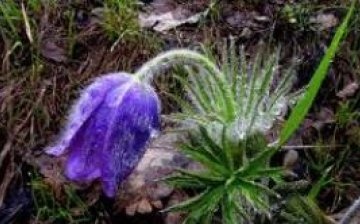Spring lumbago
Spring lumbago is also called sleep-grass. It is a perennial plant with a long oblique or upright rhizome, hairy and erect or curved stems from five to thirty centimeters in height. Basal leaves are petiolate, trifoliate, pinnately or finger-dissected, hairy, they are collected in a rosette and appear after flowering.
Flowers lumbago are single, bell-shaped, large, up to four centimeters in diameter, they bloom before the first appearance of leaves or together with them. The flowers are white inside and have a light purple hue outside. Flowering begins in the second half of May and lasts 20-25 days. The petals are densely covered with hairs on the outside, the spring lumbago has many stamens and pistils. The fruit of the lumbago is a multi-root with hairy long columns, which create a special decorative effect during the fruiting period.
Spring lumbago in the wild grows in the middle zone and in the south of Russia, the Balkans, northeast of western Europe, in Asia Minor. Lumbago in nature usually grows in sunny grassy hills and rare pine forests.
Lumbago is used as an ornamental plant. It is used on alpine slides, separately among shrubs and trees. The lumbago looks great in borders with primroses, crocuses, scyllas. After the end of the flowering period, decorative densely pubescent fruits are formed on the plant, which look good against the background of green leaves. The foliage retains its decorative effect throughout the season.
Spring lumbago in care is very unpretentious. During prolonged droughts, it requires additional watering. It tolerates winter well.



